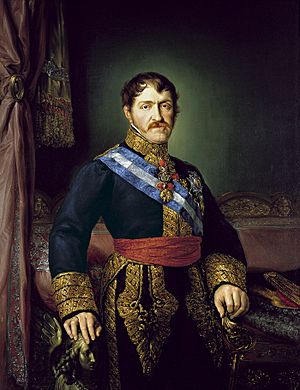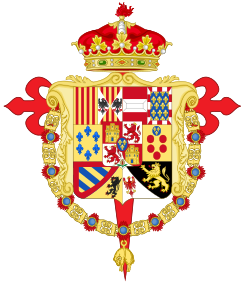Infante Carlos María Isidro of Spain facts for kids
Quick facts for kids Infante Carlos |
|||||
|---|---|---|---|---|---|
| Count of Molina | |||||

Portrait by Vicente López Portaña, c. 1823
|
|||||
| Carlist pretender to the Spanish throne as Carlos V |
|||||
| Pretendence | 1 October 1833 – 18 May 1845 | ||||
| Successor | Carlos VI | ||||
| Born | 29 March 1788 Palacio Real de Aranjuez, Spain |
||||
| Died | 10 March 1855 (aged 66) Trieste, Austria |
||||
| Burial | Trieste Cathedral | ||||
| Spouse |
Infanta Maria Francisca of Portugal
(m. 1816; died 1834) |
||||
| Issue | |||||
|
|||||
| House | Bourbon-Anjou | ||||
| Father | Charles IV of Spain | ||||
| Mother | Maria Luisa of Parma | ||||
| Signature |  |
||||
Don Carlos María Isidro Benito de Borbón (born March 29, 1788 – died March 10, 1855) was a Spanish prince. He was the second surviving son of King Charles IV of Spain. His mother was Maria Luisa of Parma.
Don Carlos became known as Charles V because he was the first person to claim the Spanish throne as a Carlist. Carlists were people who supported his claim to be king. He strongly disagreed with new, liberal ideas in Spain. He also wanted to protect the Catholic Church.
He claimed the throne after his older brother, King Ferdinand VII, died in 1833. But many people supported Ferdinand's young daughter, Isabella. This disagreement led to a big war called the First Carlist War (1833–1840).
Don Carlos had support from some regions like the Basque provinces and Catalonia. However, he lost the war and never became king. His family continued to fight for the throne in later wars, but they never won.
Contents
Early Life and Royal Family
Carlos was born on March 29, 1788, at the Palacio Real de Aranjuez in Aranjuez, Spain. In 1808, the French leader Napoleon took control of Madrid. Napoleon made Carlos's father, Charles IV, and his older brother, Ferdinand VII, give up their rights to the Spanish throne.
But Carlos, who was next in line after his brother, refused to give up his rights. He believed his right to the throne came from God. From 1808 to 1814, he and his brothers were held by Napoleon in France.
In 1814, Carlos and the Spanish royal family returned to Madrid. In September 1816, he married his niece, Infanta Maria Francisca of Portugal. She was the daughter of King John VI of Portugal. Carlos and Maria Francisca had three sons:
- Infante Carlos de Borbón y Braganza (1818–1861)
- Infante Juan de Borbón y Braganza (1822–1887)
- Infante Fernando de Borbón y Braganza (1824–1861)
Carlos did not play a big part in the government of Spain. His brother, King Ferdinand VII, had to work with some liberal groups. Ferdinand even signed a Constitution. But Carlos strongly believed that kings should rule with absolute power. He also had very strong religious beliefs.
During a time of political unrest from 1820 to 1823, Carlos was safe. Some conservatives in Spain wanted him to become king right away. But Carlos believed in the proper way of inheriting the throne. He would not fight against his own brother.
The Fight for the Throne
The Pragmatic Sanction of 1830
In May 1830, King Ferdinand VII made a new rule called the Pragmatic Sanction. This rule allowed daughters to inherit the Spanish throne, just like sons. This idea had been approved before, but it was never made official.
On October 10, 1830, Ferdinand's wife gave birth to a daughter named Isabella. Because of the new rule, Isabella became the next in line for the throne. This meant Carlos was no longer the heir.
Some religious groups still supported Carlos's claim to the throne. They thought the new rule was wrong and even illegal. They tried to help Carlos, but he only spoke about his rights. His wife and her sister, Maria Teresa, were more active in trying to help him.
In March 1833, Ferdinand told Carlos to go to Portugal. This was actually an order to remove Carlos and his supporters from Spain.
In April 1833, Ferdinand asked Carlos to promise loyalty to Isabella. Isabella was given the title of Princess of Asturias, which is for the first in line to the throne. Carlos politely but firmly refused. He said he did not want the throne for himself. But he felt he could not give up what he believed were his God-given rights.
The First Carlist War Begins
King Ferdinand VII died on September 29, 1833. In Madrid, his wife said she would rule for their young daughter, Isabella. On October 1, Carlos announced that he was the new king. He told the government officials that they could keep their jobs.
Carlos then went to the border between Portugal and Spain. But soldiers loyal to Isabella stopped him. Carlos stayed in Portugal, which was also having its own civil war. In Spain, many small rebellions started. These soon grew into the First Carlist War.
When Carlos's allies in Portugal lost their war in 1834, Carlos escaped to the United Kingdom. The British government offered him money every year if he would give up his claim to the throne. They also asked him not to return to Spain or Portugal. But Carlos refused completely.
In July, he went to France, where some royal supporters helped him. He soon joined his followers in the Pyrenees mountains of Spain. In October 1834, Isabella's government took away Carlos's rights as a Spanish prince. This was confirmed by the Spanish parliament in 1837.
Carlos stayed in Spain for five years during the war. He traveled with his armies. He did not show much skill as a general or a lot of bravery. But he faced many difficulties and often had to hide in the hills. Sometimes, a strong guide carried him over tough areas. This guide was often called the "royal jackass."
Carlos's small court was full of arguments and disagreements. Some of his supporters believed he had the true right to the throne. Others cared more about keeping local self-rule in the Basque regions. There were also fights between Carlos's military leaders and the religious leaders who had a lot of influence over him.
Early in the war, Carlos almost won several times. The last big chance was in the summer of 1837. Carlos and his army marched close to Madrid. Carlos hoped to enter the city without a fight. But when it became clear he would have to battle, he hesitated. After a few days, Carlos decided to retreat. His army then became much smaller.
His first wife died in Britain in 1834. Carlos then married her older sister, Maria Teresa of Portugal, in October 1837.
In June 1838, Carlos chose Rafael Maroto to be his main army commander. In February 1839, Maroto had four Carlist generals shot. He also criticized Carlos's court. When Carlos removed him from his job, Maroto marched to where Carlos was living and made him a prisoner. Maroto was put back in charge, and his opponents in Carlos's court were fired. Maroto then started talking secretly with Isabella's army commander. In August 1839, Maroto completely abandoned Carlos.
Final Exile and Later Life
In September 1839, Carlos left Spain for France. He was briefly put in prison there. For almost another year, some of his commanders kept fighting for him. But by July 1840, almost all fighting had stopped.
In May 1845, Carlos gave up his claim to the Spanish throne. He passed his rights to his oldest son, Carlos Luis. After this, he used the title "count of Molina." He died on March 10, 1855, in Trieste (which was then part of Austria). He is buried in the Trieste Cathedral.
During the First Carlist War, in January 1837, a law was passed. This law officially removed Don Carlos and some of his allies from the line of succession to the Spanish crown. It also took away their Spanish titles. They were called "rebels."
Heraldry
 |
 |
| Coat of Arms as Infante of Spain | Coat of Arms as Pretender |
See also
 In Spanish: Carlos María Isidro de Borbón para niños
In Spanish: Carlos María Isidro de Borbón para niños


